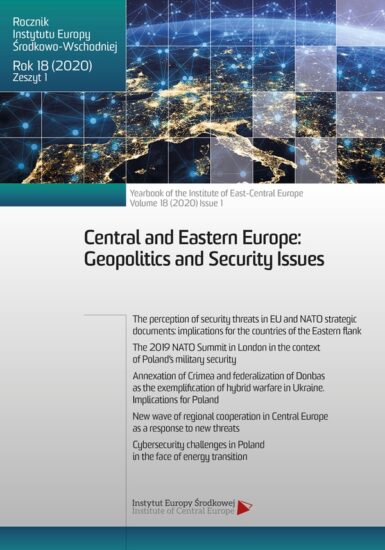ORCID: Tadeusz Zieliński: 0000-0003-0605-7684
Afiliacja: War Studies University, Poland
Strony: 25-42
Wydanie: Lublin 2020
DOI: https://doi.org/10.36874/RIESW.2020.1.2
Sposób cytowania: T. Zieliński, The perception of security threats in EU and NATO strategic documents: implications for the countries of the Eastern flank, „Rocznik Instytutu Europy Środkowo-Wschodniej” 18(2020), z. 1, s. 25-42, DOI: https://doi.org/10.36874/RIESW.2020.1.2
Słowa kluczowe: bezpieczeństwo, NATO, strategia bezpieczeństwa, Unia Europejska, wschodnia flanka, zagrożenia
Abstrakt: The anticipation of security threats is one of the key elements in the determination of objectives and the main direction for the functioning of states or organizations. It constitutes a fundamental basis for building capacity, aimed at counteracting the identified threats or limiting the emergence of new ones. This is also applicable to the European Union (EU) and North Atlantic Treaty Organization (NATO), which in their security documents identify threats that may have an impact on their existence and future development. The purpose of this article is to identify common threats to EU and NATO security, as well as to demonstrate their impact on the security of the countries of the Eastern flank. The analyses, comparisons and generalizations are based on strategic documents concerning the sphere of EU and NATO security (the EU security strategies and the NATO strategic concepts). The analyzed timeline covered the period from the end of the Cold War until the publication of the strategic documents in question. The perception of threats to the external security of the EU and NATO was contrasted with the results of public opinion polls from the member states of both organizations. The general result leads to the conclusion that the perception of security threats, contained in the strategic documents of the above-mentioned entities, is essentially identical; however, the priorities in the scope of reducing the risks associated with the occurrence of specific threats are perceived differently, including the Eastern flank countries.
Bibliografia:
‘Active Engagement, Modern Defence. Strategic Concept for the Defence and Security of the Members of the North Atlantic Treaty Organisation adopted by Heads of State and Government in Lisbon’, nato.int, 19 Novem¬ber 2010, https://www.nato.int/cps/en/natohq/official_texts_68580.htm.
Archick, K., ‘The European Union: Ongoing Challenges and Future Prospects’. Report R44249. Washington D.C.: Congressional Research Service, fas. org, December 2018, https://fas.org/sgp/crs/row/R44249.pdf.
Buzanski, M., ‘Threat Perceptions and Scenarios for EU Security and Defense. Outcomes Report of the Mercator European Dialogue Workshop Brussels – 9 July 2018’, mercatoreuropeandialogue.org, 9 July 2018, https://www. mercatoreuropeandialogue.org/download-file/726/.
Collins, B.J., NATO: A guide to the issues, Santa Barbara: Preager 2011.
Council of the European Union, ‘European Security Strategy: A Secure Eu¬rope in a Better World’, consilium.europa.eu, December 2003, https:// www.consilium.europa.eu/media/30823/qc7809568enc.pdf.
Dennison, S., Franke, U.E, Zerka, P., ‘The nightmare of the dark. The security fears that keep Europeans awake at night’, ecfr.eu, July 2018, https://www. ecfr.eu/page/-/SECURITY_SCORECARD_267.pdf.
‘Deterrence and Defence Posture Review’, nato.int, 20 May 2012, https://www. nato.int/cps/en/natohq/official_texts_87597.htm.
‘EU-NATO Cooperation. A Secure Vision for Europe. Discussion Paper’, friendsofeurope.org, June 2019, https://www.friendsofeurope.org/in¬sights/eu-nato-cooperation-a-secure-vision-for-europe/.
European External Action Service, ‘Shared Vision, Common Action: A Strong¬er Europe. A Global Strategy for the European Union’s Foreign And Se¬curity Policy’, eeas.europa.eu, June 2016, http://eeas.europa.eu/archives/ docs/top_stories/pdf/eugs_review_web.pdf.
Helwig, N., ‘New tasks for EU-NATO cooperation. Comment No. 4’, swp-berlin.org, January 2018, https://www.swp-berlin.org/fileadmin/contents/ products/comments/2018C04_hlw.pdf.
Koziej, S., ‘Ewolucja i scenariusze kształtowania się środowiska bezpieczeń¬stwa europejskiego’, in: Bezpieczeństwo Europy w globalnym świecie. Szanse i zagrożenia przyszłości w warunkach przesileń cywilizacyjnych, eds. J. Kleer, K. Prandecki, Warszawa: Polska Akademia Nauk, 2018.
Koziej, S., ‘Ewolucja strategii bezpieczeństwa Unii Europejskiej’, Myśl Ekono¬miczna i Polityczna, no. 2, 2018, DOI: 10.26399/meip.2(61).2018.23/s.koziej.
Koziej, S., ‘Strategia globalna UE: szanse i dalsze wyzwania wdrożeniowe’, pu¬laski.pl, 7 February 2017, https://pulaski.pl/wp-content/uploads/2017/02/Pulaski_Policy_Papers_Nr_3_17.pdf.
Krastev, I., After Europe, Philadelphia: University of Pennsylvania Press, 2017.
Krumm, R., Dienes, A., Weiß, S. et al., ‘Wake-up call for Europe!’, fes.de, http:// library.fes.de/pdf-files/bueros/wien/15176-20190412.pdf.
NATO, ‘The Alliance’s New Strategic Concept agreed by the Heads of State and Government participating in the Meeting of the North Atlantic Coun¬cil’, nato.int, 7-8 November 1991, https://www.nato.int/cps/en/natohq/of¬ficial_texts_23847.htm?selectedLocale=en.
NATO, ‘The Alliance’s Strategic Concept Approved by the Heads of State and Government participating in the meeting of the North Atlantic Council in Washington D.C.’, nato.int, 24 April 1999, https://www.nato.int/cps/en/ natohq/official_texts_27433.htm?selectedLocale=en
‘NATO: Ready For The Future. Adapting the Alliance (2018-2019)’, nato.int, https://www.nato.int/nato_static_fl2014/assets/pdf/pdf_2019_11/20191129_191129-adaptation_2018_2019_en.pdf.
‘NATO and the Future of Peace in Europe: Towards a Tailored Approach’, ed. M. Terlikowski, The Polish Institute of International Affairs, pism.pl, https://www.pism.pl/file/3c058bdf-39af-49d6-8700-390b8e9a13ad.
Piskorska, B., ‘Globalna strategia a redefinicja polityki Unii Europejskiej w jej sąsiedztwie’, Roczniki Nauk Społecznych, no. 1, 2018, DOI: http://dx.doi. org/10.18290/rns.2018.46.1-4.
Soloch, P., Pietrzak, P., ‘Szczyt NATO w Warszawie: uwarunkowania, rezul¬taty, wnioski dla Polski’, Bezpieczeństwo Narodowe, no. I-IV, 2016.
Svárovský, M., ‘The NATO Eastern Flank and the US Military Presence in the Region. Report 2019’, europeanvalues.net, https://www.europeanvalues. net/wp-content/uploads/2019/11/The-NATO-Eastern-Flank-and-the-US-Military-Presence-In-The-Region.pdf.
Terlikowski, M., ‘Navigating Through Threat Perceptions in Europe’, ethz.ch, 16 December 2015, https://css.ethz.ch/en/services/digital-library/articles/ article.html/195270/pdf.
‘Wales Summit Declaration Issued by the Heads of State and Government participating in the meeting of the North Atlantic Council in Wales’, nato.int, 5 September 2014, https://www.nato.int/cps/en/natohq/offi¬cial_texts_112964.htm.
‘Warsaw Summit Communiqué Issued by the Heads of State and Govern¬ment participating in the meeting of the North Atlantic Council in Warsaw 8-9 July 2016’, nato.int, 9 July 2016, https://www.nato.int/cps/en/natohq/ official_texts_133169.htm.
Słowa kluczowe: bezpieczeństwo, NATO, strategia bezpieczeństwa, Unia Europejska, wschodnia flanka, zagrożenia
PDF: Pobierz